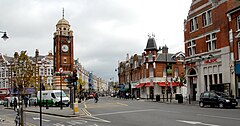Crouch End Broadway
| Crouch End | |
|---|---|
 |
|
| Crouch End shown within Greater London | |
| Population | 12,395 (2011 Census. Ward) |
| OS grid reference | TQ295885 |
| London borough | |
| Ceremonial county | Greater London |
| Region | |
| Country | England |
| Sovereign state | United Kingdom |
| Post town | LONDON |
| Postcode district | N8 |
| Dialling code | 020 |
| Police | Metropolitan |
| Fire | London |
| Ambulance | London |
| EU Parliament | London |
| UK Parliament | |
| London Assembly | |
Crouch End is an area of north London, in the London Borough of Haringey.
Crouch End is in a valley between Harringay to the east; Hornsey, Muswell Hill and Wood Green to the north; Stroud Green and Archway to the south; and Highgate to the west. Crouch End is located 4.6 miles north of Charing Cross and 5.1 miles from the City of London.
To the immediate west, it is bounded by Highgate Wood, and the adjacent Queen's Wood, as well as a large expanse of playing fields. To the north is Alexandra Park and to the south Finsbury Park. The Parkland Walk, a former railway line, makes a circuitous connection part of the way between these two parks. Other parks in the area include Stationers' Park, Priory Park and Crouch Hill Park.
Crouch End grew up as a hamlet on the old medieval route from London to the north. At this time it was governed as part of Hornsey, which became a parish in around 1300. The name "Cruch End" is recorded in 1593. This heavily wooded area contained farms and country houses, one of which was Crouch Hall, probably built in 1681 at the crossroads of Crouch End. The transcribed 1829–1848 diaries of William Copeland Astbury, recently made available, describe in great detail London life of the period, including walks to Crouch End. Crouch End remained rural until around 1880. Large parts remained in private ownership, inhibiting development. However, the development of the railway changed the area significantly. By 1887 there were seven railway stations in the area. Crouch End became a prosperous middle-class suburb due to an influx of mainly clerical workers who could easily commute to the city. The large old houses were replaced by comfortable middle-class housing, public parks were created, and a number of new roads and avenues, such as Elder Avenue and Weston Park, were laid out.
...
Wikipedia

